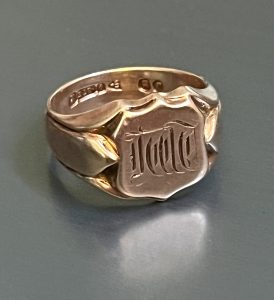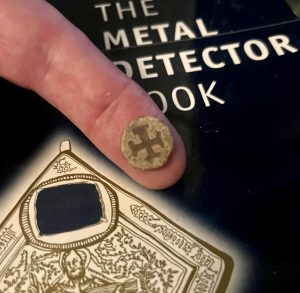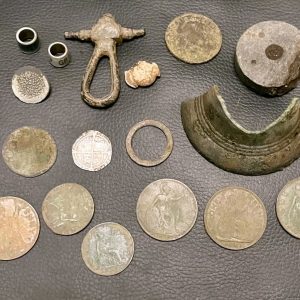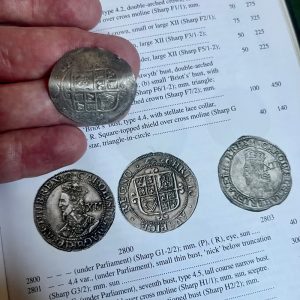
It was a warm early summer’s day earlier this year, the grass had just been cut and baled on a particular field so I decided to spend the afternoon metal detecting there. As usual I parked my car in the farmyard then attached my pinpointer and digging tool to my belt and headed off to this field, it was only about 5 minutes walk away.

Metal Detecting on a hot summer’s day is very enjoyable, but your finds are likely to be fewer than those when the ground is wet because conductivity through the ground is more effective when it is wet and less effective when it is dry. Of course digging in dry sun baked ground is also harder. So summer detecting can sometimes be a bit of a compromise.
Anyway I set off through the field heading towards the far end, I had detected this field several times before. It lies between a medieval moat and an old church and in my eyes must have been used as a route between the two. On previous occasions I had found a few hammered coins in this field in the area closest to the moat, but now I was heading towards the end nearer to the church.
I placed my bag with my snacks and drinks on one of the bales in the shade of a tree as seen above, and started to detect in lines across the width of the field. I was getting many signals and over the course of maybe two hours I had only found a musket ball, a broken button and a pre decimal copper half penny, but I was enjoying the solitude, the sun and the occasional sight of a hunting bird in the sky.
As usual I was using my XP ORX metal detector in Coin Deep mode on a mid frequency setting and of course there was the usual finds of random pieces of lead and scraps of copper. As you can imagine, most of the pieces of metal lost in a field over the centuries are of little interest to anybody and just end up in the scrap bin.
I had probably crossed the field from side to side maybe 20 times by now and I was hot and was thinking about whether it was time to stop yet, and to maybe call in at a local pub for an hour in the beer garden. I decided to do two more crossings then to call it a day.
I received a strong signal part way across the field, it was a steady number on my display but sounded quite deep. Not a good sign in those conditions but I just had to dig it. It was a bit of a struggle but I managed to dig out a plug of turf and soil to the depth of my spade and used my detector to see if whatever it was, was still the hole. It was still down there somewhere, my pinpointer then showed me that it was below the soil at the bottom of the hole just to the right of centre. Using my hand digger I carefully loosened the soil and started to remove small handfuls at a time, slow working my way down maybe just a couple of centimetres at a time, after a few more centimetres I saw a flat surface, but couldn’t quite work out what it was.
I didn’t want to damage it with my digger so I managed to wiggle it and loosen it a bit and then got a finger underneath to release it, it kind of popped up and I lifted it out and carefully brushed some loose soil off it. I knew what it was a soon as I saw it, the shape was unmistakable, it was part of an axe head and it looked very old and seemed to be made of bronze.
At this point I took a few photos and placed it carefully into the side pocket of my trousers. I decided that this was a suitable time to call it a day and to head to the pub for a quick drink before heading home.
Once I got home I had a look through my finds, not a great collection of bits, just a few old pennies, a half penny, a button, a musket ball and a couple of older well worn copper coins probably George III and of course the strange piece of axe head. I used a soft brush to clean it up a bit more, there was clearly a socket behind where the tip of a wooden handle would have fitted, although it wasn’t complete the break line seemed to be very straight, which made me wonder if it had intentionally been broken?
I took some more photo’s and sent them of to my local FLO (Finds Liaison Officer) who emailed back to say that it was a fragment of a late bronze age axe head and that it might have been intentionally broken maybe to be reused again.
Late Bronze age is around 1550-1200 BC, making this axe head more than 3000 years old. This is my only bronze age find and is a fascinating piece that had been in that field for all of this time.









